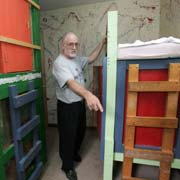 Michael Gravelle said the 6-foot-long boxes where his children slept had chicken wire and alarms, but no locks. By Lynn Ischay, The Plain Dealer via AP |
In Ohio, Michael and Sharen Gravelle abused several of their 11 adoptive children by forcing them to sleep in cagelike enclosures, a judge ruled last month in a custody hearing. A hearing today may decide whether the couple regains custody of the children, now in foster care.
In Tennessee, Debra and Tom Schmitz are charged with putting children in a metal crib — without a mattress, blanket or sheets — for sleep or punishment. Their case goes to trial Jan. 30.
Both families say they practiced so-called attachment therapy, which espouses strict discipline for children who have trouble bonding. A well-known proponent, Nancy Thomas, advocates putting alarms on kids' bedroom doors to make them feel safe. "When the alarm is working, day or night, the child can be controlled by being placed in the bedroom," she writes in her book, When Love Is Not Enough.
Prodded by a social worker, Michael Gravelle says he built the wooden structures, enclosed them with chicken wire and painted them bright colors. He says they had alarms but no locks and measured 6 feet long.
"We had to protect them from each other. They sometimes did mean things," says Sharen Gravelle of the children, who range in age from 1 to 14. She says they suffer from fetal alcohol syndrome, reactive attachment disorder and pica, which compels them to eat non-food items. All were home-schooled.
At a custody hearing last month, though, two psychologists hired by Huron County, Ohio, testified that none of the Gravelle children has reactive attachment disorder, which is relatively rare.
A school-age child of the Gravelles also testified in court that he and his siblings would be punished if they opened the doors at night and set off the alarms. He said he was forced to sleep in a bathtub for 81 days after he wet his enclosure. He said the Gravelles forced him to stay in his "box" for up to two weeks for taking peanut butter, bread and cereal from the kitchen. But he said he liked the couple and felt safe in their home.
Psychologist William Benninger, who interviewed five of the Gravelle kids for the county, testified that the enclosures could worsen the kids' behavioral problems.
The Schmitzes used the enclosures because one or two of the kids wandered at night, says Frank Deslauriers, attorney for Tom Schmitz. Barney Witherington, attorney for Debra Schmitz, says it had no lock, but a nurse who worked at the home, Sherry Dvorak, says it did.
"Many adoptive families have that (enclosed beds)," says Sharon Meyer, founder of the Foundation for Large Families. She says she adopted a boy from a family that lost parental rights because they used one.
Erin Stucky, chairwoman of the American Academy of Pediatrics' Committee on Hospital Care, says hospitals use enclosed cribs to ensure babies and toddlers don't climb out when no one is watching. "It's not meant to be a behavioral restraint," she says.
Stucky argues that children with psychiatric needs should not be enclosed but given sufficient supervision. "In most cases, when a child gets up at night, he needs to be dealt with," she says.